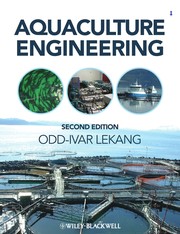Check nearby libraries
Buy this book

As aquaculture continues to grow at a rapid pace, understanding the engineering behind aquatic production facilities is of increasing importance for all those working in the industry. Aquaculture engineering requires knowledge of the many general aspects of engineering such as material technology, building design and construction, mechanical engineering, and environmental engineering. In this comprehensive book now in its second edition, author Odd-Ivar Lekang introduces these principles and demonstrates how such technical knowledge can be applied to aquaculture systems. Review of t.
Check nearby libraries
Buy this book

Previews available in: English
Showing 6 featured editions. View all 6 editions?
| Edition | Availability |
|---|---|
| 1 |
zzzz
Libraries near you:
WorldCat
|
|
2
Aquaculture Engineering
2019, Wiley & Sons, Incorporated, John, Wiley-Blackwell
in English
1119489032 9781119489030
|
zzzz
Libraries near you:
WorldCat
|
| 3 |
zzzz
Libraries near you:
WorldCat
|
| 4 |
zzzz
Libraries near you:
WorldCat
|
|
5
Aquaculture Engineering
2013, Wiley
electronic resource
in English
- 2nd ed.
1118496094 9781118496091
|
aaaa
Libraries near you:
WorldCat
|
| 6 |
zzzz
Libraries near you:
WorldCat
|
Book Details
Table of Contents
Edition Notes
7.7 Performance of protein skimmers and flotation plants in aquaculture.
References4 Fish Metabolism, Water Quality and Separation Technology; 4.1 Introduction; 4.2 Fish metabolism; 4.2.1 Overview of fish metabolism; 4.2.2 The energy budget; 4.3 Separation technology; 4.3.1 What are the impurities in water?; 4.3.2 Phosphorus removal: an example; References; 5 Adjustment of pH; 5.1 Introduction; 5.2 Definitions; 5.3 Problems with low pH; 5.4 pH of different water sources; 5.5 pH adjustment; 5.6 Examples of methods for pH adjustment; 5.6.1 Lime; 5.6.2 Sea water; 5.6.3 Lye or hydroxides; References; 6 Removal of Particles: Traditional Methods; 6.1 Introduction.
Description based on print version record.
Classifications
The Physical Object
ID Numbers
Community Reviews (0)
Feedback?History
- Created June 28, 2019
- 7 revisions
Wikipedia citation
×CloseCopy and paste this code into your Wikipedia page. Need help?
| December 19, 2023 | Edited by ImportBot | import existing book |
| October 18, 2022 | Edited by ImportBot | import existing book |
| September 17, 2021 | Edited by ImportBot | import existing book |
| September 17, 2021 | Edited by ImportBot | import existing book |
| June 28, 2019 | Created by MARC Bot | Imported from Internet Archive item record |










